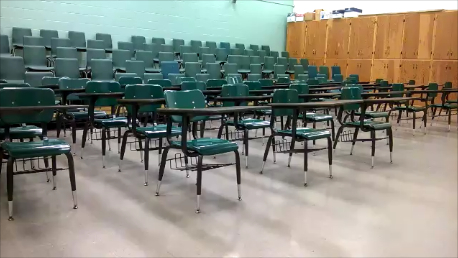"History of the Problem"
“Well, this is capitalism as absolute perfection because you have all these people making very little money doing the hardest work, supporting these programs so that people a little bit father up on the pyramid can teach their medieval literature or their seminar on Emerson or whatever it might be.”
-- William H. Thelin, Professor, University of Akron
Megan Fulwiler and Jennifer Marlow begin their survey of the “History of the Problem” of adjunct and contingent labor within higher education by laying out some disturbing statistics from the Coalition on the Academic Workforce: “In 1970 22% of Faculty in higher education were contingent,” whereas at the time of Con Job’s creation, “that number [had] reached nearly 75%.” It is significant that this information is provided shortly after a montage of aged, black-and-white photographs of university buildings and ceremonies, images that are, in turn, contrasted with a modern-day teacher reading from a collection of papers in a classroom. This juxtaposition of images, combined with such shocking trends in contingent faculty labor statistics, suggests that, given the uncertainties contingent faculty face every day, there is little room for nostalgic clinging to the “Academia” of old. There is little room for an institution that moves further and further away from its perceived role as custodian of free thought and intellectual endeavor, moving always closer toward becoming an engine of exploitation that could be the envy of any corrupt multi-national corporation.
Indeed, according to Cary Nelson, a Professor at the University of Illinois, the “English and foreign language departments” can be referred to “as the fast food disciplines because they really have originated the problem. . . . they pioneered exploitation hiring amongst the faculty.” Though Nelson lays blame at the feet of multiple departments, English is represented as the primary culprit throughout “The History of the Problem,” with English departments’ reliance on massive numbers of writing courses being blamed, specifically, for leading departments to hire an army of adjunct instructors.
Fulwiler and Marlow address yet other problems in this portion off the film, like the inflation of graduates holding advanced degrees who have very little hope of obtaining tenure track jobs given the scarcity of such positions in today’s job market. Elizabeth Conway, an English Adjunct, provides a poignant example of the impact this trend has had on people in higher education; she reflects that “[y]ou never hear a first grader say, ‘When I grow up I wanna be an adjunct teacher.’ It’s not something [she] planned on.”
The conceptualization of contingency as a cyclical process is developed throughout “The History of the Problem.” On one level, colleges and universities, according to Seth Kahn, an Associate Professor at West Chester University, represent the “minimizing [of] costs” and the “selling [of] access to higher education as a kind of economic boon, saying, ‘Hey, students, you can afford to go to college more easily if we can cheapen the cost of providing the work force for you.’” However, the other side of this exploitative coin is that, according to Bob Samuels, a Lecturer at UCLA, “the same institutions that are producing new PhD’s are also then eliminating the future jobs of those people by relying on graduate students and part time faculty.”
Higher education takes on the smoke-stained, rusted aura of the factory, a factory that consumes students’ money in exchange for a cheaply-manufactured product, only to then transform those very same students into factory workers themselves, workers whose limited mobility often prevents them from sharing in the riches they help the factory higher-ups amass.
As a result of the editing choices enabled by their choice of medium, Fulwiler and Marlow effectively lay out a “[h]istory of the [p]roblem” of contingency as lived by those who are directly impacted by it. As such, it does not reflect a voice that is distant and uninvolved.
This is no patronizing Master feigning sympathy for the suffering of their Slave. Far from it, this occult mixture of often silenced voices is laced with the suffering of the speakers themselves. It bubbles with the anguish of the marginalized and, given the statistic that nearly 75% of higher education’s faculty are contingent, this collective howling at the gates of academe should give college and university administrators something to think about.
